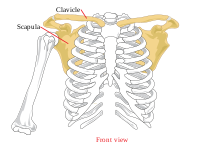
Photo from wikipedia
Introduction The coracoid process is an important anatomical structure of the scapula, which can be used as a landmark in the diagnosis and treatment of scapula related diseases, such as… Click to show full abstract
Introduction The coracoid process is an important anatomical structure of the scapula, which can be used as a landmark in the diagnosis and treatment of scapula related diseases, such as acromioclavicular joint dislocation, anterior shoulder instability, and coracoid fractures. The aim of this study was to classify the coracoid process according to morphology and to measure the morphological parameters of the coracoid process. Materials and methods A total of 377 dry and intact scapulae were collected and classified in terms of the connection between the shape of coracoid process and common things in life. The anatomical morphology and the position related to acromion and glenoid socket of the coracoid process were measured in each type by three independent researchers with a digital caliper. The measurements were averaged and recorded. Results Based on obvious morphological features, five specific types of the coracoid process were described: Type I, Vertical 8-shape; Type II, Long stick shape; Type III, Short stick shape; Type IV, Water drop shape, and Type V, Wedge shape. Type I (30%) and Type III (29%) were more prevalent in China. The tip width of the coracoid process of Type IV was the shortest and significantly different compared to the other types (p <.05), contrary to the longest in Type V. The tip thickness of the coracoid process of Type I was the shortest and significantly different from the other types (p <.05). Conclusions The coracoid process was classified into five types based on obvious morphological features. Knowing of morphological classification and anatomical parameters of different types of the coracoid process, to some extent, may be helpful to diagnose and treat the shoulder joint disease, such as acromioclavicular joint dislocation, anterior shoulder instability, and coracoid fractures, and to theoretically reduce postoperative complications.
Journal Title: Journal of Orthopaedic Surgery
Year Published: 2022
Link to full text (if available)
Share on Social Media: Sign Up to like & get
recommendations!